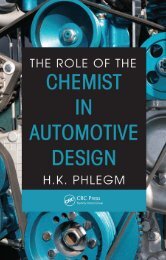Lightweight Electric/Hybrid Vehicle Design
Lightweight Electric/Hybrid Vehicle Design
Lightweight Electric/Hybrid Vehicle Design
Create successful ePaper yourself
Turn your PDF publications into a flip-book with our unique Google optimized e-Paper software.
Current EV design approaches 5<br />
there is now a solution to this problem, with a reforming process developed by Hydrogen Power<br />
Corporation/Engelhard called Thermal Catalytic Reforming. Put simply, it is the chemical<br />
process:<br />
3Fe + 4H O = Fe O + 4H and Fe O + 2C = 3Fe + 2CO 2 3 4 2 3 4 2<br />
The first process takes place with a catalyst at 130° C. The hydrogen is stored in a hydride tank<br />
until required. The iron is returned to a central facility for reduction by the second process. The<br />
main points about this cycle are that a high proportion of hydrocarbon heat energy is converted<br />
into hydrogen and that 1 kg of iron provides enough hydrogen for a small car to travel 6 km on a<br />
fuel cell.<br />
IC engines and gas turbines run well on most hydrocarbons and hydrogen. Fuel cells need<br />
hydrogen. Hydrogen has to be used and stored safely. This could be achieved by reforming it on<br />
demand at fuel stations – the waste heat would be used to generate electricity to be pumped back<br />
into the national grid. The primary fuel could be any hydrocarbon such as petrol, diesel, methanol,<br />
propane or methane. The only constraint is that the fuel source must have low sulphur content so<br />
as not to poison the catalyst. In the UK, we have a head start called the Natural Gas Grid. This is<br />
likely to become of critical importance for energy distribution, removing the need to distribute<br />
petrol and diesel by road. To satisfy future transport needs, we retain our ‘fuel’ stations as the<br />
means of distribution. This brings us to the problem of on-board hydrogen storage.<br />
l. Petrol car: A journey of 68 miles each day consumes 2.5 gallons of fuel and takes 2 hours.<br />
Amount of energy in fuel = 5.14 x 10 8 joules<br />
Thermal power = 71.3 kW<br />
Mechanical power = 20 kW average<br />
Efficiency = 28%<br />
2. Battery electric car as secondary transport.<br />
Power station efficiency 40%<br />
<strong>Electric</strong> car efficiency 80%<br />
OVERALL 32%<br />
CONCLUSION: Pollution is moved from car to power station. There is only an environmental<br />
return if the car’s performance is sacrificed or the power station is non-thermal and range/<br />
performance is limited.<br />
3. <strong>Hybrid</strong> car as primary transport.<br />
Hydrocarbon to electricity<br />
Via lean burn petrol engine 45%<br />
<strong>Electric</strong>ity to mechanical power 90%<br />
OVERALL 40.5%<br />
CONCLUSION: Pollution reduced by 55% and fuel consumption is 70% of petrol vehicle with<br />
performance/range as the petrol vehicle.<br />
4. Fuel-cell electric car as primary transport.<br />
Hydrocarbon to hydrogen conversion 80%<br />
Fuel-cell hydrogen to electricity 60%<br />
<strong>Electric</strong>ity to mechanical power 90%<br />
OVERALL 43% (potential for 48% in 10 years)<br />
CONCLUSION: Pollution reduced by 90%; fuel consumption is 66% of petrol vehicle and<br />
performance/range is as petrol vehicle.<br />
Fig. 1. 2 Some crude comparisons for fuel related to pollution.







